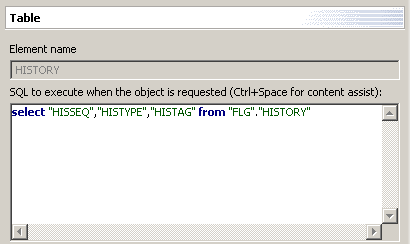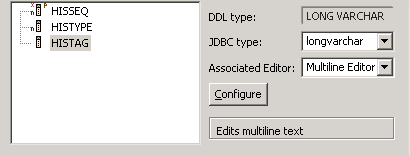DbEdit Table Properties
The table property page allows you do change DbEdit's behaviour when
dealing with database tables. Any values changed here will be applied
to
the table object if you press OK
or Apply and made persistent
in
the offline cache. That's why an element that is not offline available
prior to changing it's properties will be after as well as its parent
elements. In the Tables View a marker prefix ('>') is assigned to
elements that's properties have been set, so it is easy to
identify later what you have changed.
Select Statement
 The upper area
contains the statement used when opening the Table Editor. Normally it should look
like select <column_list>
from <table_name>. You are not restricted to change this
statement any way you want. However, for table elements that are not
persisted queries you may have created using the SQL
Editors Execute Action (Ctrl+Alt+E) it should at least remain a
select over the table it describes.
The upper area
contains the statement used when opening the Table Editor. Normally it should look
like select <column_list>
from <table_name>. You are not restricted to change this
statement any way you want. However, for table elements that are not
persisted queries you may have created using the SQL
Editors Execute Action (Ctrl+Alt+E) it should at least remain a
select over the table it describes.
One of the purposes for allowing you to change the statement is the
reordering of columns which is not supported by the widget used to show
the table content.
Columns
 In the lower area
there is the list of columns produced by the
actually selected statement. As already stated, this list should
normally be identical
to
the list of columns of the database table.
In the lower area
there is the list of columns produced by the
actually selected statement. As already stated, this list should
normally be identical
to
the list of columns of the database table.
If you select one of the columns, the combo boxes right to the columns
list will be updated with values associated to that column.
JDBC Type
You can
assign a new JDBC type to the column. The only reason to do this is a
difference between the JDBC type and the DDL type, which is the type
that was probably used to create the table. Some JDBC drivers report
the
JDBC type OTHER while there is an appropriate type they could report,
e.g. TIMESTAMP. The Table Editor cannot automatically detect the
right JDBC type without assistance. This property page lets you
'override' the data type and provide the Table Editor with that
assistance.
Associated Editor
Another combo box lets you associate cell editors to columns
other than the default text or combo box editors. The editors
listed here are implementations of the Interface dbedit.ui.editor.table.ICellEditor
and are registered using
the DbEdit Extension point dbedit.ui.CellEditor.
There are two cell editors listed by default, the Multiline Editor and External Editor. The Multiline
Editor
supports you with editing of text that has line breaks. The External
Editor is an OLE Editor (available on Win32 only) that can be used to
edit OLE documents with a specific file
type. To choose a file type you have to press the Configure button and select one from
the list.

 The upper area
contains the statement used when opening the Table Editor. Normally it should look
like select <column_list>
from <table_name>. You are not restricted to change this
statement any way you want. However, for table elements that are not
persisted queries you may have created using the SQL
Editors Execute Action (Ctrl+Alt+E) it should at least remain a
select over the table it describes.
The upper area
contains the statement used when opening the Table Editor. Normally it should look
like select <column_list>
from <table_name>. You are not restricted to change this
statement any way you want. However, for table elements that are not
persisted queries you may have created using the SQL
Editors Execute Action (Ctrl+Alt+E) it should at least remain a
select over the table it describes. In the lower area
there is the list of columns produced by the
actually selected statement. As already stated, this list should
normally be identical
to
the list of columns of the database table.
In the lower area
there is the list of columns produced by the
actually selected statement. As already stated, this list should
normally be identical
to
the list of columns of the database table.